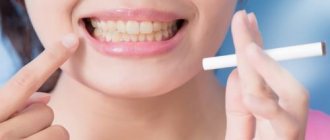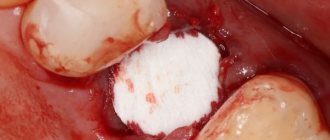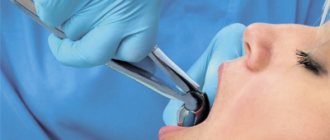From this article you will learn:
- How much can you not eat after tooth extraction?
- what antibiotics and rinses to use,
- How long after you can smoke after tooth extraction?
The article was written by a dental surgeon with more than 19 years of experience.
If you have just had a tooth removed, it is very important to know what to do after tooth extraction. This will prevent complications that often arise as a result of patient behavior errors (inflammation of the socket, development of bleeding or swelling of the soft tissues of the face). And I will try to summarize my experience accumulated over many years of work as a dental surgeon in this article.
The most common mistake is that patients rinse their mouth too much, which leads to the blood clot falling out of the socket. As a result, we will get inflammation of the socket of the extracted tooth - alveolitis of the socket. Either the patient took aspirin before or after tooth extraction (without thinking that aspirin thins the blood) and, accordingly, in this case we will have a high risk of bleeding and hematoma formation.
Tooth extraction: photo
Also at the end of the article you will be able to see what the sockets of extracted teeth should normally look like (at different times after extraction). This will help you decide if you need to re-examine with your dental surgeon.
What to do with a gauze swab -
A tooth was removed today: what to do after removal with a gauze swab on the socket... A swab soaked in blood is an excellent breeding ground for infection. And the longer you keep it in the mouth, the greater the risk of developing inflammation in the socket of the extracted tooth. If you still have a gauze swab on your socket, you need to remove it urgently. It is advisable to do this without jerking and not strictly vertically, but sideways (so as not to pull out the blood clot from the hole along with the tampon).
An exception may be a situation where the hole is still being touched up - in this case, the gauze swab can be held for a little longer. But it’s best to spit out this old gauze swab soaked in saliva and blood, make a new one from a sterile bandage, and place it on top of the hole (biting firmly).
Important: saliva at first may normally turn pink due to the secretion of ichor (this should not be confused with bleeding). At the same time, it is not clear why many patients stop swallowing saliva and accumulate it in the oral cavity. There is absolutely no need to do the latter; saliva can be swallowed as usual.
How soon can you eat after tooth extraction?
Most often, patients are interested in when they can eat after tooth extraction and what food is best to eat. You can safely eat after 2 hours, but on the same side (where the tooth was removed) it is not advisable to chew anything dense or hard in the first days after extraction. This is necessary in order not to injure the fresh blood clot in the socket of the extracted tooth.
You can drink water immediately after tooth extraction. As for food, if you still can’t wait 2 hours, then you can absolutely safely drink a glass of kefir or eat yogurt right away. In general, there is no ban on any specific foods; it is only necessary that the prepared food be soft in the first days (for example, if there is meat, then it must be cured).
What and when to eat
You can't eat or drink for the first three hours. First, during anesthesia, you can bite your cheek or tongue. Secondly, the blood clot must harden in the hole.
After this, you can eat, but you should avoid hot, cold, spicy and rough foods. You should absolutely not drink hot drinks: they will not only increase blood flow, but can also dissolve the protective clot.
If the removal was difficult, the dentist will recommend a diet of soft and liquid foods for a day or two.
Chew food with the teeth located on the non-operated side.
Apply cold to prevent swelling -
What to do after tooth extraction to prevent the development of swelling... As soon as you come home, your first actions are to take ice or a piece of frozen meat from the freezer, wrap it in a towel and apply it to your cheek in the projection of the extracted tooth (24stoma.ru). This is necessary to avoid or reduce possible swelling of the soft tissues of the face that may develop (especially if the removal was difficult).
It is necessary to hold the ice 3-4 times for 5 minutes, with an interval of 5-10 minutes between each approach. It makes sense to keep ice only in the first hours after removal, then it is useless. But heating and applying heat is strictly forbidden, because... In this case, suppuration is guaranteed.
Important: if you want to avoid the development of swelling of the soft tissues of the face as much as possible, then in addition to using cold, be sure to take antihistamines (anti-allergic) medications in the first 2-3 days after removal. This group of drugs also has a good anti-edematous effect. Suprastin is especially suitable: 1 tablet per day before bed (for 2-3 days).
Gum condition
Pain in the gums may occur after the anesthetic drug wears off, that is, after 3-4 hours. After the procedure, the patient is often worried about the return of painful sensations and the release of ichor (for 4–6 hours. After the operation, the wound looks quite scary, especially if a wisdom tooth was removed.
In the absence of pathology, the healing process occurs in several stages.
Is it possible to drink alcohol after tooth extraction?
Due to the stress they have experienced, many patients separately ask whether it is possible to drink alcohol after tooth extraction. In general, drinking alcohol is contraindicated during the first 24 hours after removal, but if the doctor has prescribed antibiotics, then alcohol should not be taken during the entire course of antibiotic therapy (i.e. 5-7 days).
If antibiotics were not prescribed, then, of course, a small amount of weak alcohol is unlikely to cause any consequences. But large doses can lead to the fact that the hole may begin to bleed again, or a hematoma may appear.
What not to do after tooth extraction -
What absolutely cannot be done after tooth extraction...
- for the first 1-2 days, you should not take a hot bath (a warm shower is fine), or sleep lying on the side of the extracted tooth - all this will contribute to the appearance of swelling,
- visit the pool or sauna during the week,
- engage in heavy labor (to avoid bleeding),
- picking at the wound with foreign objects, tongue,
- open your mouth wide and make active facial movements, because if stitches were placed, they may come apart,
- do not take aspirin as a pain reliever (it thins the blood and thereby promotes bleeding and bruising),
- You should not rinse your mouth intensively in the first 2-3 days, because intensive rinsing can lead to a blood clot falling out of the socket (this will certainly lead to its inflammation).
Painkillers –
If the extraction was simple, you may not need pain relief after tooth extraction. But if you want to completely prevent the appearance of pain, then it is better to take a strong tablet analgesic even before the anesthesia wears off (which one is better to choose - see the link, but remember that after removal you cannot take aspirin).
Sometimes the pain is very severe. As a rule, this happens if the removal was performed by a doctor in a very traumatic way or if inactive bone fragments were left behind. The pain is most severe when the doctor used a drill to drill out the bone, and water cooling was not used (this leads to necrosis of bone tissue as a result of overheating).
Important: numerous studies show that the severity of pain after tooth extraction is reduced by an average of 30-50% if the doctor places sutures on the socket of the extracted tooth. In addition, bringing the edges of the mucous membrane together by applying sutures helps protect the blood clot from loss and injury, sharply reduces the risk of developing inflammation of the socket, and almost completely eliminates the occurrence of bleeding.
After a simple simple extraction, most dental surgeons very rarely use sutures. I can recommend for the future - always before removal, ask your surgeon to put 1-2 stitches on you, even if the removal is simple, and even if you have to pay an extra 300-400 rubles for it. As a rule, sutures do not have to be removed (they dissolve on their own), but they will reduce pain and reduce the risk of complications.
Is it possible to smoke?
The question of the possibility of smoking during the postoperative period worries all heavy smokers. Giving up a habit developed over the years is not so easy, even for the sake of your own health. Tooth extraction is not a very complicated operation, but it still injures tissues and creates a wound, sometimes a large one. Therefore, it is very important to observe certain restrictions that apply to cigarettes.
For those who absolutely cannot live without smoking, the minimum abstinence time is 2 hours. And this is provided that the bleeding quickly stops. If the blood continues to ooze, then under no circumstances should you even touch the cigarette until it disappears completely. Chemical components and resins only irritate the wound and increase bleeding.
Tobacco smoke heats and dries out the tooth socket, preventing a blood clot from forming. And it is designed to protect the open wound from infection, and also promotes rapid healing and tightening. This situation is fraught with the occurrence of inflammation and, subsequently, alveolitis.
Complex dental surgery may require sutures. In this case, smoking is prohibited for 7-10 days until the stitches are removed. Nicotine prevents their resorption, which means wound healing. If living without cigarettes is absolutely impossible, then you need to be patient for at least a couple of days. Not only the restoration of the oral cavity, but also health in general depends on this.
Tooth extraction is usually quick and painless. The period of recovery and healing of the wound is very important, when you need to follow all the doctor’s recommendations. A gentle regime for several days and following simple rules will relieve possible health problems.
previous post
How to remove tartar at home?
next post
Antiseptic rinses/baths –
Remember that you should not rinse your mouth vigorously during the first few days after removal, because... you can easily rinse the blood clot out of the socket. Food will constantly accumulate in a hole without a clot and rot there, causing inflammation and pain. It is better to replace rinses with baths (pour an antiseptic solution into your mouth, hold it and spit it out, or lightly “squelch” it).
When are antiseptic baths necessary?
- if the tooth was removed due to inflammation,
- an incision was made on the gum to expose the gumboil,
- if you have teeth with untreated caries or dental plaque, infection in which can lead to suppuration of a blood clot.
Antiseptic baths are best done with an aqueous solution of Chlorhexidine 0.05-0.12%. This drug has a pronounced antiseptic effect and is slightly bitter in taste. Baths should be done 3 times a day (keep the solution in your mouth for about 1 minute each time).
Antibiotics after tooth extraction –
Antibiotics after tooth extraction should be prescribed by a dental surgeon and not taken independently. An antibiotic for tooth extraction is always prescribed in situations where -
- the tooth was removed due to inflammation,
- it was difficult to remove
- there is a risk of complications.
Amoxiclav after tooth extraction is one of the most effective and popular drugs among dental surgeons, because it has affinity for bone tissue. Adults need Amoxiclav 625 mg (each tablet contains amoxicillin 500 mg and clavulanic acid 125 mg). The drug is taken 2 times a day for 5 to 7 days. But we DO NOT RECOMMEND taking this drug, because... immediately in 10-25% of patients - it causes antibiotic-associated diarrhea. Follow the link above to read a review article on the use of antibiotics in dentistry.
Reduce the risk of developing diarrhea when taking Amoxiclav or Augmentin - if you combine it with taking Metronidazole (Trichopol). This combination is not only safer in terms of diarrhea, but also significantly enhances the antibacterial effect. The antibiotic Metronidazole is especially effective against anaerobic bacteria and protozoa, which are especially numerous in chronic purulent inflammation (for example, in the area of the roots of teeth), while Amoxiclav and Augmentin do not have a clinically significant effect on protozoa.
But the risk of diarrhea will be lowest when using fluoroquinolone antibiotics. Among the antibiotics of this group, we especially highlight the combination drugs “Tsiprolet-A” or “Tsifran-ST”, which in addition to 500 mg of ciprofloxacin also contain 600 mg of tinidazole. Fluoroquinolones themselves cause diarrhea in only 1-2% of cases, but the above drugs also contain tinidazole (an analogue of metronidazole). Tinidazole also has antiprotozoal activity, i.e. it will be effective against anaerobic microorganisms, including Clostridium difficile and Clostridium perfringens, which are responsible for the development of diarrhea while taking antibiotics,
Important: because These antibiotics are not cheap - as an alternative, we will also indicate such a drug as the usual “Tsiprolet”, which contains only ciprofloxacin (without tinidazole). This antibiotic costs only 90 rubles per pack, but it is slightly less effective for purulent inflammation than the antibiotics Tsiprolet-A or Tsifran-ST.
Another antibiotic that everyone knows about is Lincomycin 0.25 (taken 2 capsules 3 times a day, usually 5 days). This is an inexpensive, moderately effective drug, but it kills all life in the intestines due to poor bioavailability (only 30% of the drug is absorbed from the intestines if taken on an empty stomach, and only 6% when taken with food). Therefore, it may turn out that, having bought a cheap antibiotic, you will then have to “expensively” restore the intestinal microflora.
How to reduce the risk of diarrhea after taking antibiotics -
Of course, parallel intake of probiotics (i.e., drugs that contain bacteria beneficial to our intestines) can help you with this. There are a large number of probiotics, but the best of them are Linex and Bifiform. Keep in mind that it is better to choose multicomponent preparations that contain several types of beneficial bacteria. Probiotics may contain lactobacilli, bifidobacteria, enterococci, and their combinations.
Probiotic Bifiform (30 capsules) –
If there is blood coming from the hole -
There are several effective methods to stop bleeding.
Most often, the wound bleeds in people who have high blood pressure (hypertension). However, a rise in blood pressure can be triggered in completely healthy people due to psychological stress. The first thing to do is to apply a tightly twisted swab of sterile bandage to the wound, and then immediately measure the pressure. And if it is elevated, take the appropriate drug. For more information on how to stop bleeding, read the article: → “How to stop bleeding from a tooth socket at home”
If you have high blood pressure -
If you regularly measure your blood pressure, if it is higher than normal, take the appropriate medication. Otherwise, there is a very high risk of bleeding or hematoma formation. The first can lead to weakness and dizziness, and the formation of a hematoma is fraught with its suppuration and the need to open it.
If you have diabetes -
If you have a device for determining blood sugar, it is advisable to immediately measure your sugar. The stress of removal contributes to the release of adrenaline, the concentration of which largely determines blood sugar levels. This will help you prevent feeling unwell.
Removing sutures after removal –
After tooth extraction, the sutures are usually removed no later than 7-8 days. However, removal of sutures may not be necessary if, for example, catgut is used as a suture material. This material dissolves on its own within 10 days. When you see that the seams are very loose, you can simply remove them with clean fingers.
Treatment of teeth after extraction –
It is advisable to continue treatment after tooth extraction no earlier than 7 days later. If the removal was difficult, then sometimes it may take up to 14 days. This is due to the fact that carious teeth contain a lot of pathogenic infection, which, when drilling a tooth, can easily get into a blood clot and lead to suppuration.
What could be the consequences?
If the bleeding does not stop flowing for too long, it is necessary to seek help as soon as possible from the medical staff of the clinic where the operation took place. Don’t be needlessly nervous and stress yourself out; perhaps this phenomenon has a completely logical explanation.
Prolonged bleeding can lead to the following unpleasant consequences: severe weakness and exhaustion of the body, poor health, drowsiness, drop in blood pressure and headaches. Also, such patients have pale skin and may lose consciousness. However, we are only talking about a large loss of blood.
Also among the complications is the so-called “dry” socket. In the absence of a clot covering the entrance to the tooth bed, it becomes very vulnerable. Food particles, dangerous microbes and bacteria can get into it, which over time will lead to the beginning of the rotting process.
Against the background of incessant bleeding, a serious inflammatory process can develop: alveolitis, phlegmon, osteomyelitis, etc. If the patient notices a strong increase in body temperature, increased pain, and the appearance of purulent discharge, this with a 99% probability indicates an infection in the wound.
previous post
How to choose toothpaste?
next entry
What should a socket of an extracted tooth normally look like?
As you will see below, the blood clot after tooth extraction first has an intense burgundy color. Gradually, the surface of the clot becomes whitish/yellowish (this is normal, because fibrin effusion occurs). Normally, the blood clot should be dense the next day. If the clot becomes loose, this means it has disintegrated, and you should familiarize yourself with the symptoms of inflammation of the socket in order to consult a doctor in time.
What does the gum look like after tooth extraction (normal) –
Oral care after tooth extraction –
The oral cavity requires careful care after tooth extraction. Teeth should be brushed as usual, including the group of teeth in the area of the extracted tooth. The latter are simply cleaned more carefully so as not to injure the blood clot. You also need to carefully rinse your mouth from foam so as not to rinse the clot out of the hole.
You also need to care for your gums after tooth extraction (antiseptic baths, which we described above, are sufficient for this). But the lack of proper hygiene will cause the accumulation of soft microbial plaque, which is fraught with suppuration of the hole and the development of alveolitis. We hope that the article on the topic: Tooth pulled out, what to do - was useful to you!
Sources:
1. Dental education of the author of the article, 2. Based on personal experience as a dental surgeon, 3. National Library of Medicine (USA), 4. “Outpatient surgical dentistry” (Bezrukov V.), 5. “Propaedeutics of surgical dentistry” (Soloviev M.).
Traditional medicine methods
Alternative medicine methods, of course, can be effective, but you still need to be careful. If the problem becomes serious, it is better to contact the doctor who removed your tooth. However, in some cases the following folk advice will help:
- Apply a cotton swab dipped in aloe juice, furatsilin (in the ratio of 2 furatsilin tablets per glass of water), valerian or echinacea decoction to the wound.
- Place a brewed bag of good black tea on the hole. Tea leaves contain tannins, which constrict blood vessels and slow down bleeding.
- Apply a turunda (gauze or cotton swab) soaked in chamomile and nettle infusion to the diseased area of the gum.
Do not rinse your mouth with solutions or tinctures under any circumstances, as this has a mechanical effect on the hole. Rinsing is allowed only from the third day.










